Survey on Optical Wireless Communication with Intelligent Reflecting Surfaces
Abstract
1. Introduction
1.1. B5G with IRSs
1.2. Recent Surveys on IRSs
1.3. Contributions of This Survey
- A brief introduction and summary of the mirror array-based IRS model in OWC systems.
- A detailed review of the recent development of mirror array-based and metasurface-based IRS in OWC systems.
2. Mirror Array-Based IRSs in OWC Systems
2.1. OWC System Model with Mirror Array-Based IRSs
2.2. OWC Systems with Mirror Array-Based IRSs
2.2.1. Channel Gain Optimization
| Year | Optical Source | Channel Type | Receiver | Optimization Objective | Optimization Algorithm | Comment | Ref. |
|---|---|---|---|---|---|---|---|
| 2020 | LD | Free Space | PD | Outage probability | N/A | Dynamic channel | [47,48] |
| 2020 | LED | Indoor | PD | Channel gain | Author’s algorithm | Energy efficient | [46] |
| 2021 | LED | Indoor | PD | Data rate | Sine–cosine algorithm | N/A | [22] |
| 2021 | LED | Indoor | PD | Data rate | Relaxing greedy algorithm | N/A | [49] |
| 2021 | LD | Free Space | PD | Outage probability | N/A | Atmospheric turbulence | [18,42] |
| 2021 | LED | Indoor | PD | Secure | PSO algorithm | N/A | [21] |
| 2022 | LD | Underwater | N/A | Outage probability | N/A | Underwater turbulence | [50] |
| 2022 | LED | Indoor | PD | Channel gain | Genetic Algorithm | NOMA | [45] |
| 2022 | LED | Indoor | PD | Channel gain | MM algorithm | SE maximization | [41] |
| 2022 | LED | Indoor | PD | Channel gain | Cyclic search algorithm | MISO | [51] |
| 2022 | LED | Outdoor | PD | Channel gain | BSCI algorithm | V2V | [52] |
| 2023 | LD | Underwater | N/A | Outage probability | N/A | Underwater turbulence | [53] |
| 2023 | LED | Indoor | PD | Channel gain | N/A | FD channel | [54] |
| 2023 | LED | Indoor | PD | Energy | ANN | SLIPT | [55] |
| 2024 | LED | Indoor | PD | Channel Gain | N-step localization algorithm | VLP | [40] |
| 2024 | LED | Indoor | PD | Secure | PSO algorithm | Multiple APs | [56] |
| 2024 | LED | Indoor | PD | Data rate | ANN-based algorithm | Blockage Avoidance | [57] |
| Algorithm 1 MM algorithm to solve the IRS optimization problem [41] |
|
| Algorithm 2 BSCI algorithm [52] |
|
2.2.2. Link Reliability Optimization
2.2.3. Data Rate Optimization
2.2.4. Security Optimization
2.2.5. Energy Optimization
3. Metasurface-Based IRSs in OWC Systems
3.1. Signal Reflection with Metasurface-Based IRSs
3.2. Signal Refraction with Metasurface-Based IRSs
3.2.1. Beam Shaping with Metasurface IRSs
3.2.2. FOV Enhancement with Metasurface IRSs
4. Conclusions and Future Scope
Author Contributions
Funding
Institutional Review Board Statement
Informed Consent Statement
Data Availability Statement
Conflicts of Interest
Abbreviations
| ACRLB | Achievable Cramer–Rao Lower Bound |
| ANN | Artificial Neural Network |
| AP | Access Point |
| B5G | Beyond Fifth-Generation |
| BER | Bit Error Rate |
| BSCI | Binary Search–Conditional Iteration |
| CAFAB | Circular Auto-Focusing Airy Beams |
| CCC | Communication Control Center |
| CDF | Cumulative Distribution Function |
| CMOS | Complementary Metal–Oxide–Semiconductor |
| CSI | Channel State Information |
| DCO-OFDM | Direct Current-biased Optical Orthogonal Frequency-Division Multiplexing |
| DP-QPSK | Dual-Polarization Quadrature Phase Shift Keying |
| EE | Energy Efficiency |
| EDFAs | Erbium-Doped Fiber Amplifiers |
| ETPM | Electrically Tunable Multifunctional Polarization-Dependent Metasurface |
| FD | Frequency Domain |
| FEC | Forward Error Correction |
| FOV | Field of View |
| FSO | Free-Space Optics |
| GA | Genetic Algorithm |
| Gbps | Gigabits per second |
| GML | Geometric and Misalignment Loss |
| IM/DD | Intensity Modulation/Direct Detection |
| IRS | Intelligent Reflecting Surfaces |
| LC | Liquid crystal |
| LCP | Left-Handed Circularly Polarized |
| LD | Laser Diode |
| LED | Light-Emitting Diode |
| LP | Linearly Polarized |
| LOS | Line-of-Sight |
| MEC | Mobile Edge Computing |
| MEMS | Micro-Electromechanical Systems |
| MIMO | Multiple-Input–Multiple-Output |
| MISO | Multiple-Input–Single-Output |
| ML | Maximum Likelihood |
| MM | Minorization–Maximization |
| mmWave | Millimeter-Wave |
| NLOS | Non-Line-of-Sight |
| NOMA | Non-Orthogonal Multiple Access |
| OTOPS | Oceanic Turbulence Optical Power Spectrum |
| OWC | Optical Wireless Communication |
| OXC | Optical Cross Connector |
| PD | Photodiode |
| Probability Density Function | |
| PDL | Polarization-Dependent Loss |
| PIN | Positive–Intrinsic–Negative |
| PSO | Particle Swarm Optimization |
| PtMP | Point-to-Multipoint |
| QOS | Quality of Service |
| QP | Quadratic Programming |
| RCP | Right-Handed Circularly Polarized |
| RF | Radiofrequency |
| RGB | Red, Green, and Blue |
| RMSE | Root-Mean-Square Error |
| ROP | Received optical power |
| RSS | Reflected Spot Search |
| RSS | Received Signal Strength |
| SE | Spectral Efficiency |
| SEM | Scanning Electron Microscope |
| SISO | Single-Input–Single-Output |
| SLIPT | Simultaneous Lightwave Information and Power Transfer |
| SNR | Signal-to-Noise Ratio |
| SOI | Silicon-On-Insulator |
| Tbps | Terabits per second |
| TDMA | Time-Division Multiple Access |
| THz | Terahertz |
| UAV | Unmanned Aerial Vehicles |
| UOWC | Underwater Optical Wireless Communication |
| V2V | Vehicle-to-Vehicle |
| VLC | Visible-Light Communication |
| VLP | Visible-Light Positioning |
| WDM | Wavelength-Division Multiplexing |
References
- Wang, K.; Song, T.; Wang, Y.; Fang, C.; He, J.; Nirmalathas, A.; Lim, C.; Wong, E.; Kandeepan, S. Evolution of Short-Range Optical Wireless Communications. J. Light. Technol. 2023, 41, 1019–1040. [Google Scholar] [CrossRef]
- Khalighi, M.A.; Uysal, M. Survey on free space optical communication: A communication theory perspective. IEEE Commun. Surv. Tutor. 2014, 16, 2231–2258. [Google Scholar] [CrossRef]
- Koonen, T. Indoor optical wireless systems: Technology, trends, and applications. J. Light. Technol. 2017, 36, 1459–1467. [Google Scholar] [CrossRef]
- Aboagye, S.; Ndjiongue, A.R.; Ngatched, T.M.N.; Dobre, O.A.; Poor, H.V. RIS-Assisted Visible Light Communication Systems: A Tutorial. IEEE Commun. Surv. Tutor. 2023, 25, 251–288. [Google Scholar] [CrossRef]
- Niu, Y.; Li, Y.; Jin, D.; Su, L.; Vasilakos, A.V. A survey of millimeter wave communications (mmWave) for 5G: Opportunities and challenges. Wirel. Netw. 2015, 21, 2657–2676. [Google Scholar] [CrossRef]
- Koenig, S.; Lopez-Diaz, D.; Antes, J.; Boes, F.; Henneberger, R.; Leuther, A.; Tessmann, A.; Schmogrow, R.; Hillerkuss, D.; Palmer, R.; et al. Wireless sub-THz communication system with high data rate. Nat. Photonics 2013, 7, 977–981. [Google Scholar] [CrossRef]
- Chen, Z.; Ma, X.; Zhang, B.; Zhang, Y.; Niu, Z.; Kuang, N.; Chen, W.; Li, L.; Li, S. A survey on terahertz communications. China Commun. 2019, 16, 1–35. [Google Scholar] [CrossRef]
- Alimi, I.; Shahpari, A.; Sousa, A.; Ferreira, R.; Monteiro, P.; Teixeira, A. Challenges and opportunities of optical wireless communication technologies. In Optical Communication Technology; IntechOpen: London, UK, 2017. [Google Scholar] [CrossRef]
- Garg, D.; Nain, A. Next generation optical wireless communication: A comprehensive review. J. Opt. Commun. 2023, 44, s1535–s1550. [Google Scholar] [CrossRef]
- Kaushal, H.; Kaddoum, G. Underwater optical wireless communication. IEEE Access 2016, 4, 1518–1547. [Google Scholar] [CrossRef]
- Islam, S.R.; Avazov, N.; Dobre, O.A.; Kwak, K.S. Power-domain non-orthogonal multiple access (NOMA) in 5G systems: Potentials and challenges. IEEE Commun. Surv. Tutor. 2016, 19, 721–742. [Google Scholar] [CrossRef]
- Ding, Z.; Lei, X.; Karagiannidis, G.K.; Schober, R.; Yuan, J.; Bhargava, V.K. A survey on non-orthogonal multiple access for 5G networks: Research challenges and future trends. IEEE J. Sel. Areas Commun. 2017, 35, 2181–2195. [Google Scholar] [CrossRef]
- Dai, L.; Wang, B.; Ding, Z.; Wang, Z.; Chen, S.; Hanzo, L. A survey of non-orthogonal multiple access for 5G. IEEE Commun. Surv. Tutor. 2018, 20, 2294–2323. [Google Scholar] [CrossRef]
- Yin, L.; Popoola, W.O.; Wu, X.; Haas, H. Performance evaluation of non-orthogonal multiple access in visible light communication. IEEE Trans. Commun. 2016, 64, 5162–5175. [Google Scholar] [CrossRef]
- Tyson, R.K. Bit-error rate for free-space adaptive optics laser communications. JOSA A 2002, 19, 753–758. [Google Scholar] [CrossRef]
- Lee, E.J.; Chan, V.W. Part 1: Optical communication over the clear turbulent atmospheric channel using diversity. IEEE J. Sel. Areas Commun. 2004, 22, 1896–1906. [Google Scholar] [CrossRef]
- Tsiftsis, T.A.; Sandalidis, H.G.; Karagiannidis, G.K.; Uysal, M. Optical wireless links with spatial diversity over strong atmospheric turbulence channels. IEEE Trans. Wirel. Commun. 2009, 8, 951–957. [Google Scholar] [CrossRef]
- Najafi, M.; Schmauss, B.; Schober, R. Intelligent reflecting surfaces for free space optical communication systems. IEEE Trans. Commun. 2021, 69, 6134–6151. [Google Scholar] [CrossRef]
- Minovich, A.E.; Miroshnichenko, A.E.; Bykov, A.Y.; Murzina, T.V.; Neshev, D.N.; Kivshar, Y.S. Functional and nonlinear optical metasurfaces. Laser Photonics Rev. 2015, 9, 195–213. [Google Scholar] [CrossRef]
- Yu, N.; Genevet, P.; Kats, M.A.; Aieta, F.; Tetienne, J.P.; Capasso, F.; Gaburro, Z. Light propagation with phase discontinuities: Generalized laws of reflection and refraction. Science 2011, 334, 333–337. [Google Scholar] [CrossRef]
- Qian, L.; Chi, X.; Zhao, L.; Chaaban, A. Secure visible light communications via intelligent reflecting surfaces. In Proceedings of the ICC 2021-IEEE International Conference on Communications, Montreal, QC, Canada, 14–23 June 2021; IEEE: Piscataway, NJ, USA, 2021; pp. 1–6. [Google Scholar]
- Aboagye, S.; Ngatched, T.M.; Dobre, O.A.; Ndjiongue, A.R. Intelligent reflecting surface-aided indoor visible light communication systems. IEEE Commun. Lett. 2021, 25, 3913–3917. [Google Scholar] [CrossRef]
- Valagiannopoulos, C.; Tsiftsis, T.A.; Kovanis, V. Metasurface-enabled interference mitigation in visible light communication architectures. J. Opt. 2019, 21, 115702. [Google Scholar] [CrossRef]
- Abdelhady, A.M.; Salem, A.K.S.; Amin, O.; Shihada, B.; Alouini, M.S. Visible light communications via intelligent reflecting surfaces: Metasurfaces vs mirror arrays. IEEE Open J. Commun. Soc. 2020, 2, 1–20. [Google Scholar] [CrossRef]
- Abumarshoud, H.; Mohjazi, L.; Dobre, O.A.; Di Renzo, M.; Imran, M.A.; Haas, H. LiFi through reconfigurable intelligent surfaces: A new frontier for 6G? IEEE Veh. Technol. Mag. 2021, 17, 37–46. [Google Scholar] [CrossRef]
- Glybovski, S.B.; Tretyakov, S.A.; Belov, P.A.; Kivshar, Y.S.; Simovski, C.R. Metasurfaces: From microwaves to visible. Phys. Rep. 2016, 634, 1–72. [Google Scholar] [CrossRef]
- Ndjiongue, A.R.; Ngatched, T.M.; Dobre, O.A.; Haas, H. Re-configurable intelligent surface-based VLC receivers using tunable liquid-crystals: The concept. J. Light. Technol. 2021, 39, 3193–3200. [Google Scholar] [CrossRef]
- Aboagye, S.; Ndjiongue, A.R.; Ngatched, T.M.; Dobre, O.A. Design and optimization of liquid crystal RIS-based visible light communication receivers. IEEE Photonics J. 2022, 14, 1–7. [Google Scholar] [CrossRef]
- Gong, S.; Lu, X.; Hoang, D.T.; Niyato, D.; Shu, L.; Kim, D.I.; Liang, Y.C. Toward smart wireless communications via intelligent reflecting surfaces: A contemporary survey. IEEE Commun. Surv. Tutor. 2020, 22, 2283–2314. [Google Scholar] [CrossRef]
- Hassouna, S.; Jamshed, M.A.; Rains, J.; Kazim, J.U.R.; Rehman, M.U.; Abualhayja, M.; Mohjazi, L.; Cui, T.J.; Imran, M.A.; Abbasi, Q.H. A survey on reconfigurable intelligent surfaces: Wireless communication perspective. IET Commun. 2023, 17, 497–537. [Google Scholar] [CrossRef]
- Hassouna, S. A Survey on Intelligent Reflecting Surfaces: Wireless Communication Perspective. Authorea Prepr. 2023. [Google Scholar] [CrossRef]
- Zheng, B.; You, C.; Mei, W.; Zhang, R. A survey on channel estimation and practical passive beamforming design for intelligent reflecting surface aided wireless communications. IEEE Commun. Surv. Tutor. 2022, 24, 1035–1071. [Google Scholar] [CrossRef]
- Chen, Z.; Ma, X.; Han, C.; Wen, Q. Towards intelligent reflecting surface empowered 6G terahertz communications: A survey. China Commun. 2021, 18, 93–119. [Google Scholar] [CrossRef]
- Raza, A.; Ijaz, U.; Ishfaq, M.K.; Ahmad, S.; Liaqat, M.; Anwar, F.; Iqbal, A.; Sharif, M.S. Intelligent reflecting surface-assisted terahertz communication towards B5G and 6G: State-of-the-art. Microw. Opt. Technol. Lett. 2022, 64, 858–866. [Google Scholar] [CrossRef]
- Zhu, Y.; Mao, B.; Kato, N. Intelligent reflecting surface in 6G vehicular communications: A survey. IEEE Open J. Veh. Technol. 2022, 3, 266–277. [Google Scholar] [CrossRef]
- Mohsan, S.A.H.; Khan, M.A.; Alsharif, M.H.; Uthansakul, P.; Solyman, A.A. Intelligent reflecting surfaces assisted UAV communications for massive networks: Current trends, challenges, and research directions. Sensors 2022, 22, 5278. [Google Scholar] [CrossRef]
- Renzo, M.D.; Debbah, M.; Phan-Huy, D.T.; Zappone, A.; Alouini, M.S.; Yuen, C.; Sciancalepore, V.; Alexandropoulos, G.C.; Hoydis, J.; Gacanin, H.; et al. Smart radio environments empowered by reconfigurable AI meta-surfaces: An idea whose time has come. EURASIP J. Wirel. Commun. Netw. 2019, 2019, 129. [Google Scholar] [CrossRef]
- Luo, S.; Hao, J.; Ye, F.; Li, J.; Ruan, Y.; Cui, H.; Liu, W.; Chen, L. Evolution of the electromagnetic manipulation: From tunable to programmable and intelligent metasurfaces. Micromachines 2021, 12, 988. [Google Scholar] [CrossRef]
- Ma, Q.; Bai, G.D.; Jing, H.B.; Yang, C.; Li, L.; Cui, T.J. Smart metasurface with self-adaptively reprogrammable functions. Light. Sci. Appl. 2019, 8, 98. [Google Scholar] [CrossRef]
- Kokdogan, F.; Gezici, S. Intelligent Reflecting Surfaces for Visible Light Positioning based on Received Power Measurements. IEEE Trans. Veh. Technol. 2024, 1–14. [Google Scholar] [CrossRef]
- Sun, S.; Yang, F.; Song, J.; Han, Z. Joint resource management for intelligent reflecting surface–aided visible light communications. IEEE Trans. Wirel. Commun. 2022, 21, 6508–6522. [Google Scholar] [CrossRef]
- Najafi, M.; Schober, R. Intelligent reflecting surfaces for free space optical communications. In Proceedings of the 2019 IEEE Global Communications Conference (GLOBECOM), Waikoloa, HI, USA, 9–13 December 2019; IEEE: Piscataway, NJ, USA, 2019; pp. 1–7. [Google Scholar]
- Jamali, V.; Ajam, H.; Najafi, M.; Schmauss, B.; Schober, R.; Poor, H.V. Intelligent reflecting surface assisted free-space optical communications. IEEE Commun. Mag. 2021, 59, 57–63. [Google Scholar] [CrossRef]
- Yang, L.; Guo, W.; da Costa, D.B.; Alouini, M.S. Free-space optical communication with reconfigurable intelligent surfaces. arXiv 2020, arXiv:2012.00547. [Google Scholar]
- Abumarshoud, H.; Selim, B.; Tatipamula, M.; Haas, H. Intelligent reflecting surfaces for enhanced NOMA-based visible light communications. In Proceedings of the ICC 2022-IEEE International Conference on Communications, Seoul, Republic of Korea, 16–20 May 2022; IEEE: Piscataway, NJ, USA, 2022; pp. 571–576. [Google Scholar]
- Cao, B.; Chen, M.; Yang, Z.; Zhang, M.; Zhao, J.; Chen, M. Reflecting the light: Energy efficient visible light communication with reconfigurable intelligent surface. In Proceedings of the 2020 IEEE 92nd Vehicular Technology Conference (VTC2020-Fall), Victoria, BC, Canada, 18 November–16 December 2020; IEEE: Piscataway, NJ, USA, 2020; pp. 1–5. [Google Scholar]
- Wang, H.; Zhang, Z.; Zhu, B.; Dang, J.; Wu, L.; Wang, L.; Zhang, K.; Zhang, Y. Performance of wireless optical communication with reconfigurable intelligent surfaces and random obstacles. arXiv 2020, arXiv:2001.05715. [Google Scholar]
- Wang, X.; Zhang, M.; Zhou, H.; Ren, X. Performance analysis and design considerations of the shallow underwater optical wireless communication system with solar noises utilizing a photon tracing-based simulation platform. Electronics 2021, 10, 632. [Google Scholar] [CrossRef]
- Sun, S.; Yang, F.; Song, J. Sum rate maximization for intelligent reflecting surface-aided visible light communications. IEEE Commun. Lett. 2021, 25, 3619–3623. [Google Scholar] [CrossRef]
- Naik, R.P.; Chung, W.Y. Evaluation of reconfigurable intelligent surface-assisted underwater wireless optical communication system. J. Light. Technol. 2022, 40, 4257–4267. [Google Scholar] [CrossRef]
- Wu, Q.; Zhang, J.; Guo, J. Capacity maximization for reconfigurable intelligent surface-aided MISO visible light communications. Photonics 2022, 9, 487. [Google Scholar] [CrossRef]
- Zhan, L.; Zhao, H.; Zhang, W.; Lin, J. An optimal scheme for the number of mirrors in vehicular visible light communication via mirror array-based intelligent reflecting surfaces. Photonics 2022, 9, 129. [Google Scholar] [CrossRef]
- Ata, Y.; Abumarshoud, H.; Bariah, L.; Muhaidat, S.; Imran, M.A. Intelligent reflecting surfaces for underwater visible light communications. IEEE Photonics J. 2023, 15, 1–10. [Google Scholar] [CrossRef]
- Chen, C.; Huang, S.; Abumarshoud, H.; Tavakkolnia, I.; Safari, M.; Haas, H. Frequency-domain channel characteristics of intelligent reflecting surface assisted visible light communication. J. Light. Technol. 2023, 41, 7355–7369. [Google Scholar] [CrossRef]
- Palitharathna, K.W.; Vegni, A.M.; Suraweera, H.A. SLIVER: A SLIPT-enabled IRS-assisted VLC system for energy optimization. In Proceedings of the 2023 IEEE 20th International Conference on Mobile Ad Hoc and Smart Systems (MASS), Toronto, ON, Canada, 25–27 September 2023; IEEE: Piscataway, NJ, USA, 2023; pp. 143–151. [Google Scholar]
- Qian, L.; Zhao, L.; Huang, N.; Chaaban, A.; Xu, Z. Security enhancement by intelligent reflecting surfaces for visible light communications. Opt. Commun. 2024, 570, 130851. [Google Scholar] [CrossRef]
- Palitharathna, K.W.; Vegni, A.M.; Diamantoulakis, P.D.; Suraweera, H.A.; Krikidis, I. Handover Management through Reconfigurable Intelligent Surfaces for VLC under Blockage Conditions. arXiv 2024, arXiv:2402.16873. [Google Scholar]
- Li, Q.T.; Dong, F.; Wang, B.; Gan, F.; Chen, J.; Song, Z.; Xu, L.; Chu, W.; Xiao, Y.F.; Gong, Q.; et al. Polarization-independent and high-efficiency dielectric metasurfaces for visible light. Opt. Express 2016, 24, 16309–16319. [Google Scholar] [CrossRef] [PubMed]
- Tao, J.; You, Q.; Yang, C.; Li, Z.; Deng, L.; Wu, M.; Luo, M.; Wu, L.; Li, C.; Liu, Z.; et al. Beam-steering metasurfaces assisted coherent optical wireless multichannel communication system. Nanophotonics 2023, 12, 3511–3518. [Google Scholar] [CrossRef]
- Khalid, R.; Wu, Q.Y.S.; Mahmood, N.; Deng, J.; Nematic, A.; Valiyaveedu, S.K.; Cabrera, H.; Mehmood, M.Q.; Teng, J.; Zubair, M. Fluid-Responsive Tunable Metasurfaces for High-Fidelity Optical Wireless Communication. Mater. Horizons 2024. [Google Scholar] [CrossRef]
- Ndjiongue, A.R.; Ngatched, T.M.; Dobre, O.A.; Haas, H. Toward the use of re-configurable intelligent surfaces in VLC systems: Beam steering. IEEE Wirel. Commun. 2021, 28, 156–162. [Google Scholar] [CrossRef]
- Cao, Z.; Zhang, X.; Osnabrugge, G.; Li, J.; Vellekoop, I.M.; Koonen, A.M. Reconfigurable beam system for non-line-of-sight free-space optical communication. Light. Sci. Appl. 2019, 8, 69. [Google Scholar] [CrossRef]
- Shirmanesh, G.K.; Sokhoyan, R.; Wu, P.C.; Atwater, H.A. Electro-optically tunable multifunctional metasurfaces. ACS Nano 2020, 14, 6912–6920. [Google Scholar] [CrossRef]
- Hu, Y.; Ou, X.; Zeng, T.; Lai, J.; Zhang, J.; Li, X.; Luo, X.; Li, L.; Fan, F.; Duan, H. Electrically tunable multifunctional polarization-dependent metasurfaces integrated with liquid crystals in the visible region. Nano Lett. 2021, 21, 4554–4562. [Google Scholar] [CrossRef]
- Mermet-Lyaudoz, R.; Combeau, P.; Drouard, E.; Julien-Vergonjanne, A.; Seassal, C.; Nguyen, H.S.; Sahuguede, S. Multiscale simulation for visible light communication using perovskite metasurface. In Proceedings of the 2021 17th International Symposium on Wireless Communication Systems (ISWCS), Berlin, Germany, 6–9 September 2021; IEEE: Piscataway, NJ, USA, 2021; pp. 1–6. [Google Scholar]
- Tao, J.; You, Q.; Li, Z.; Luo, M.; Liu, Z.; Qiu, Y.; Yang, Y.; Zeng, Y.; He, Z.; Xiao, X.; et al. Mass-Manufactured Beam-Steering Metasurfaces for High-Speed Full-Duplex Optical Wireless-Broadcasting Communications. Adv. Mater. 2022, 34, 2106080. [Google Scholar] [CrossRef]
- Hu, J.; Guo, Z.; Shi, J.; Jiang, X.; Chen, Q.; Chen, H.; He, Z.; Song, Q.; Xiao, S.; Yu, S.; et al. A metasurface-based full-color circular auto-focusing Airy beam transmitter for stable high-speed underwater wireless optical communications. Nat. Commun. 2024, 15, 2944. [Google Scholar] [CrossRef]
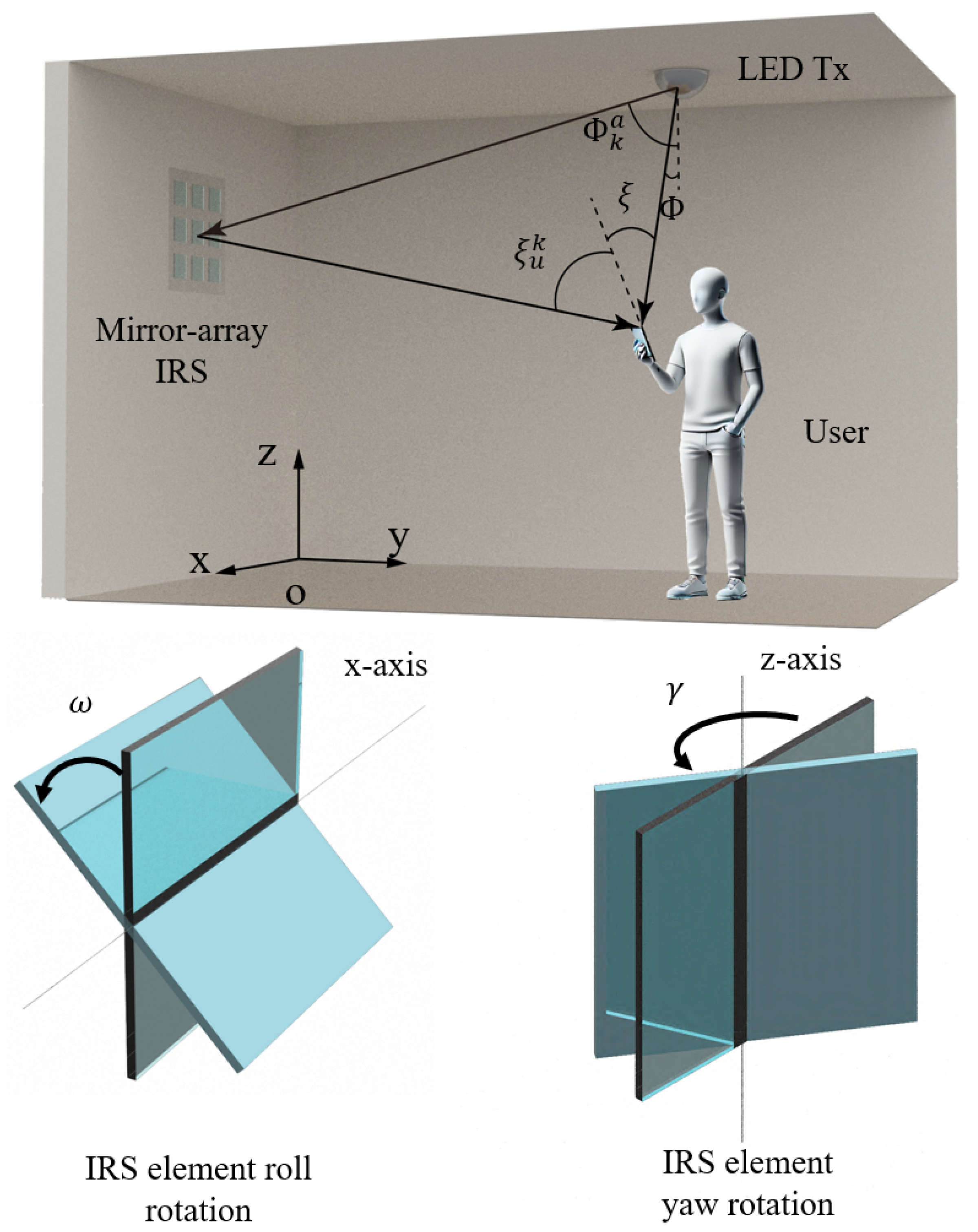
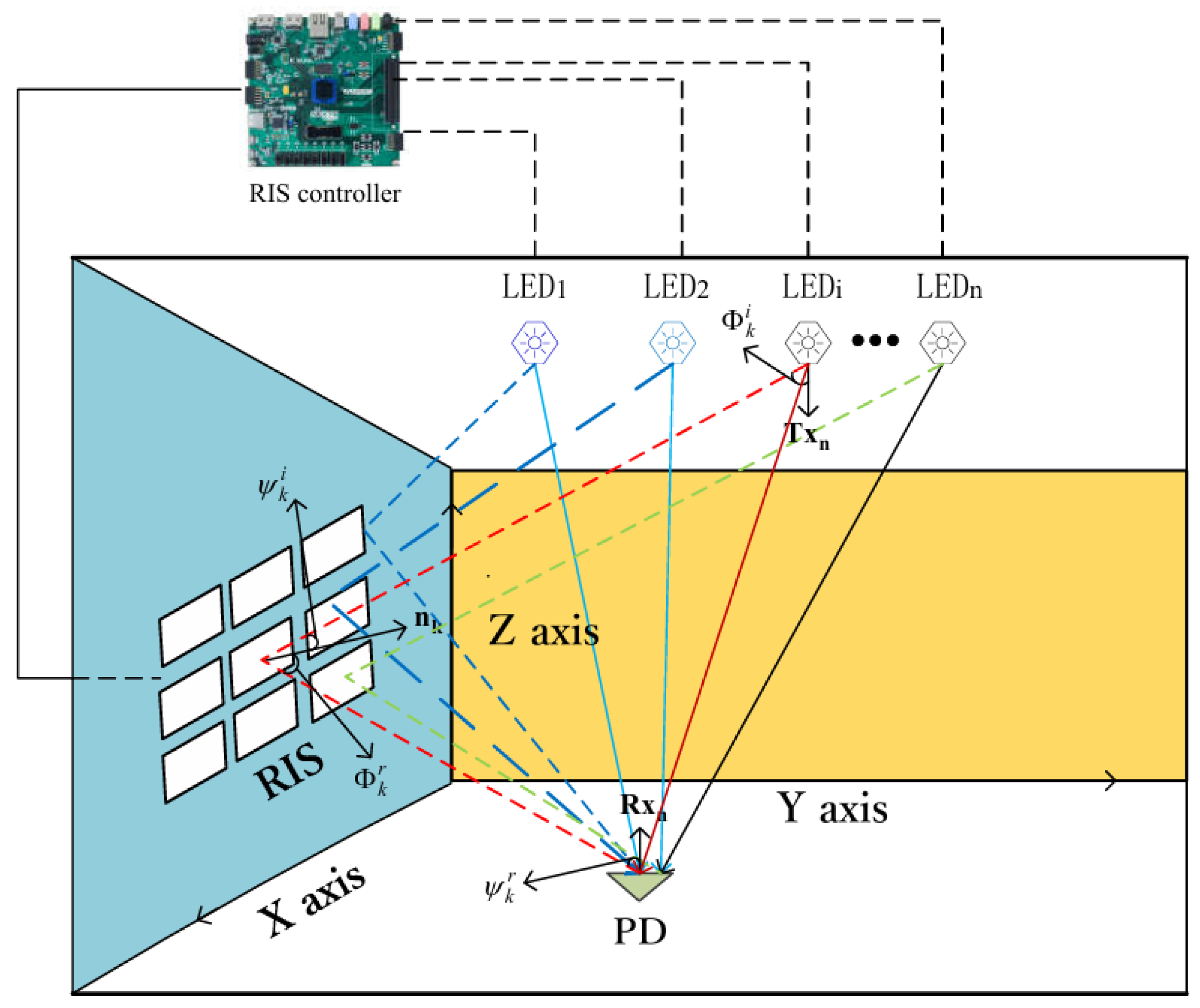
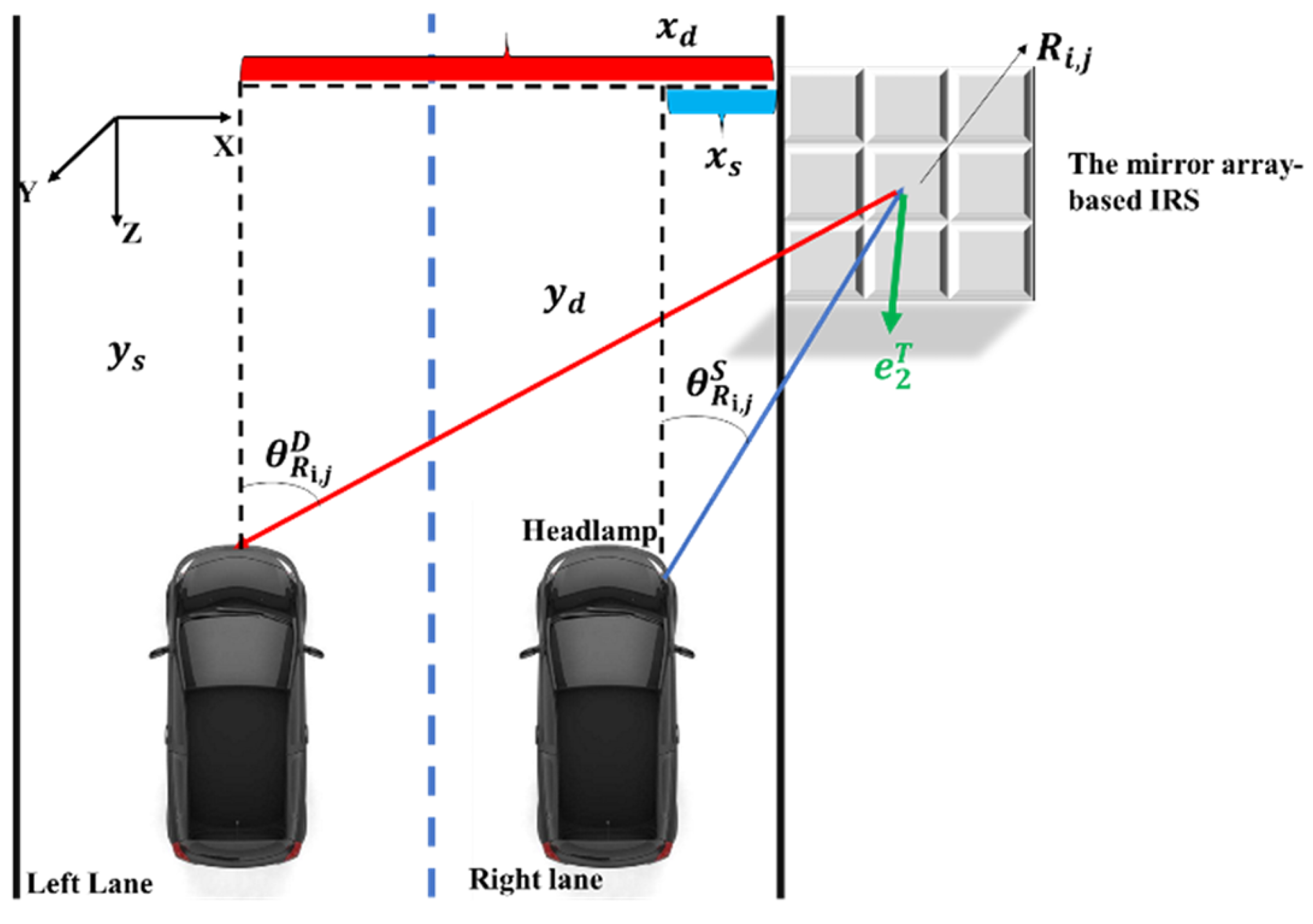
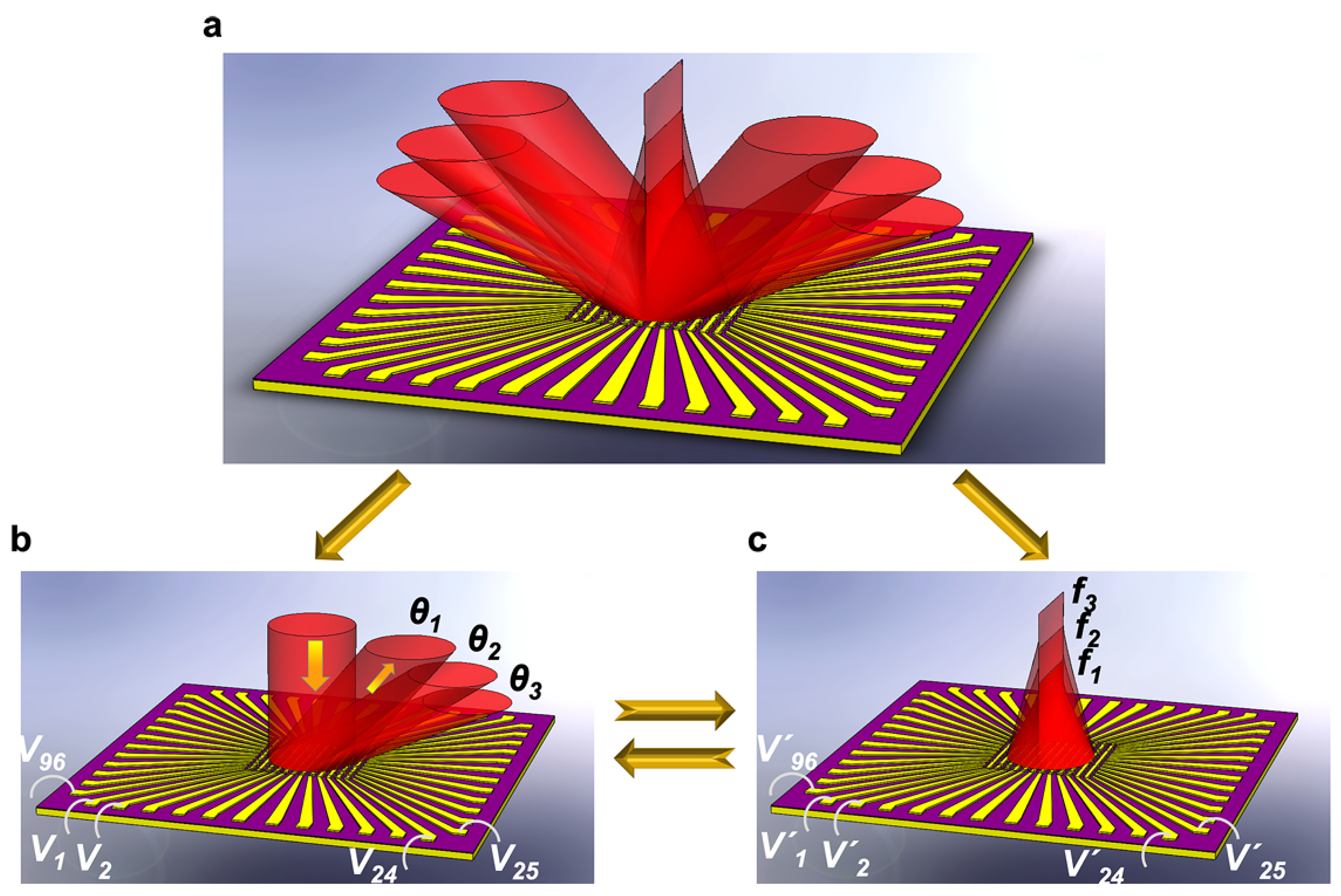
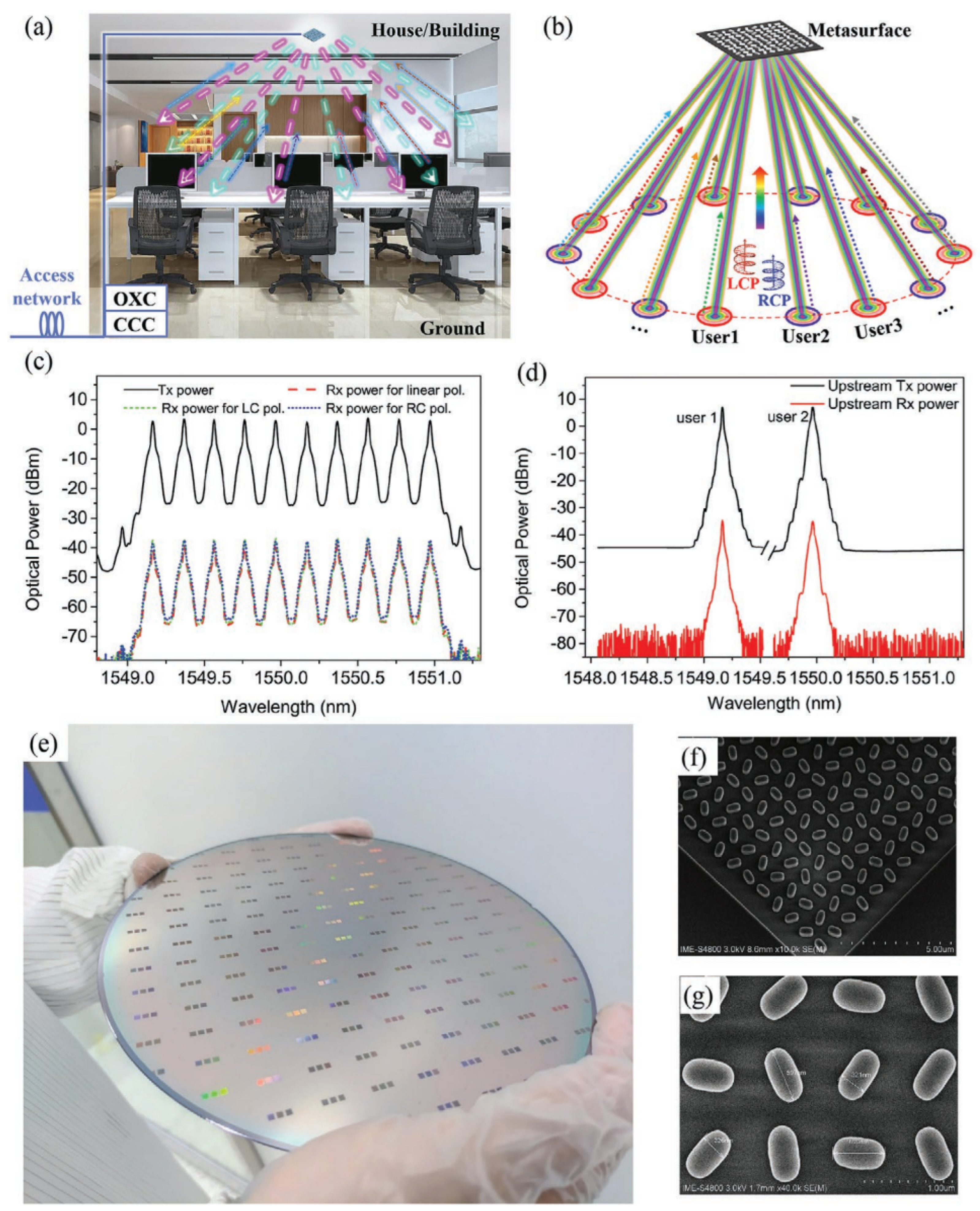

| mmWave Systems | THz Systems | OWC System | FSO System | |
|---|---|---|---|---|
| Distance | Long (several kilometers in ideal conditions, tens to hundreds of meters in urban environments) | Short (a few meters to several hundreds of meters in ideal conditions) | Limited (tens to hundreds of meters indoors) | Several kilometers (can be much longer in space-based systems (lunar-to-Earth or deep space)) |
| Carrier frequency | Low (30 GHz to 300 GHz) | Moderate (0.1 THz to 10 THz) | High (hundreds of THz) | High (hundreds of THz) |
| Bandwidth | Several GHz | Tens to hundreds of GHz | Broad (in the order of THz) | Broad (in the order of THz) |
| Data rate | Tens of Gbps | Tens to hundreds of Gbps | Tbps | Tbps |
| Reference | Year | Area of Focus |
|---|---|---|
| RF Systems | ||
| Gong et al. [29] | 2020 | • IRS applications and design in future wireless networks • Concepts and reconfigurability • Joint optimization • Performance improvements |
| Hassouna et al. [30,31] | 2023 | • IRSs in enhancing wireless networks • Hardware, control, and channel models • Performance metrics • Challenges |
| Zheng et al. [32] | 2022 | • IRS-aided wireless communications • Design issues • New architectures • Applications |
| mmWave/THz Systems | ||
| Chen et al. [33] | 2021 | • IRSs in THz communications for 6G • Application scenarios • Enabling technologies • Challenges |
| Raza et al. [34] | 2022 | • IRSs in THz communication for B5G/6G • Performance analysis • Enhancing reliability and data rates |
| Zhu et al. [35] | 2022 | • IRSs in 6G vehicular communications • Signal strength and security • Positioning accuracy |
| Mohsan et al. [36] | 2022 | • IRS and UAV integration • Literature and technologies • Application scenarios |
| OWC Systems | ||
| Abumarshoud et al. [25] | 2021 | • IRS-assisted LiFi systems • IRS architecture • Operational elements • Major challenges |
| Sylvester et al. [4] | 2023 | • IRSs in OWC systems • Indoor applications • Key challenges |
| This survey | 2024 | • IRSs in OWC systems • Mirror array models • Recent developments • Major challenges and future scope |
| Year | Application Type | Operation Wavelength | Dimensions | Ref. |
|---|---|---|---|---|
| 2019 | Reconfigurable beam system for NLOS OWC | 1520–1620 nm | N/A | [62] |
| 2020 | Electro-optically tunable multifunctional metasurfaces | 1522 nm | 400 nm periodicity, various layer thicknesses | [63] |
| 2021 | Liquid-crystal IRS-based receivers | 600 nm | 0.75 mm thicknesses | [61] |
| 2021 | Electrically Tunable Polarization-Dependent Metasurfaces for dynamic optical applications | 450 nm, 532 nm, 635 nm | 400 nm period, 500 nm height TiO2 nanofins | [64] |
| 2021 | Perovskite metasurface for multiscale-optimized VLC | 535–580 nm | 135 nm depth, 295–460 nm period | [65] |
| 2022 | Beam-steering metasurfaces for full-duplex optical communication | 1550 nm | 2 mm × 2 mm | [66] |
| 2022 | Liquid-crystal IRS-based receivers | 510–670 nm | 0.75 mm thicknesses | [28] |
| 2023 | Metasurface-enhanced coherent multichannel OWC | 1550–1555.8 nm | 801.6 m × 801.6 m | [59] |
| 2024 | UOWC with metasurfaces auto-focusing Airy beam transmitter | 440–640 nm | 300 nm period, 800 nm height TiO2 nanopillars | [67] |
| 2024 | Tunable metasurfaces with fluid responsiveness | 1550 nm | 500 m × 500 m | [60] |
Disclaimer/Publisher’s Note: The statements, opinions and data contained in all publications are solely those of the individual author(s) and contributor(s) and not of MDPI and/or the editor(s). MDPI and/or the editor(s) disclaim responsibility for any injury to people or property resulting from any ideas, methods, instructions or products referred to in the content. |
© 2024 by the authors. Licensee MDPI, Basel, Switzerland. This article is an open access article distributed under the terms and conditions of the Creative Commons Attribution (CC BY) license (https://creativecommons.org/licenses/by/4.0/).
Share and Cite
Fang, C.; Li, S.; Wang, Y.; Wang, K. Survey on Optical Wireless Communication with Intelligent Reflecting Surfaces. Photonics 2024, 11, 830. https://doi.org/10.3390/photonics11090830
Fang C, Li S, Wang Y, Wang K. Survey on Optical Wireless Communication with Intelligent Reflecting Surfaces. Photonics. 2024; 11(9):830. https://doi.org/10.3390/photonics11090830
Chicago/Turabian StyleFang, Chengwei, Shuo Li, Yinong Wang, and Ke Wang. 2024. "Survey on Optical Wireless Communication with Intelligent Reflecting Surfaces" Photonics 11, no. 9: 830. https://doi.org/10.3390/photonics11090830
APA StyleFang, C., Li, S., Wang, Y., & Wang, K. (2024). Survey on Optical Wireless Communication with Intelligent Reflecting Surfaces. Photonics, 11(9), 830. https://doi.org/10.3390/photonics11090830






